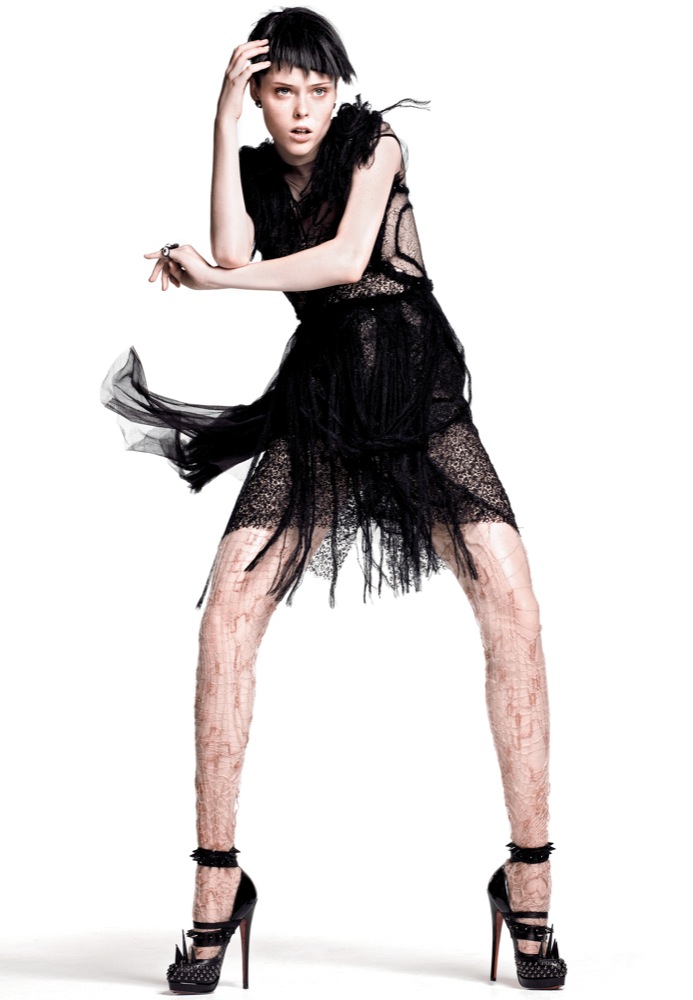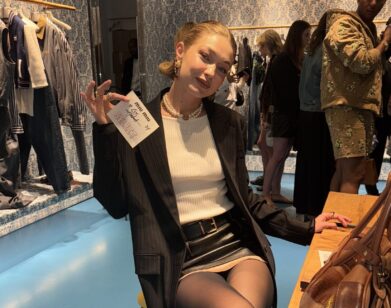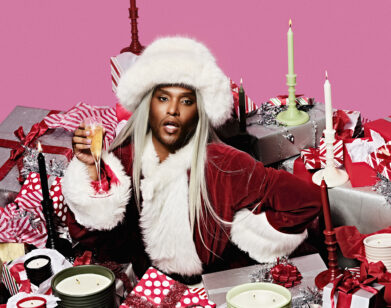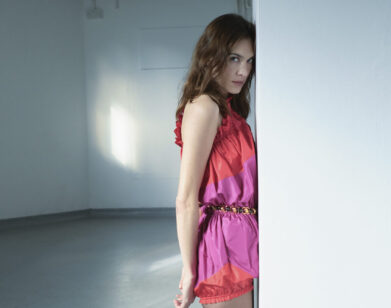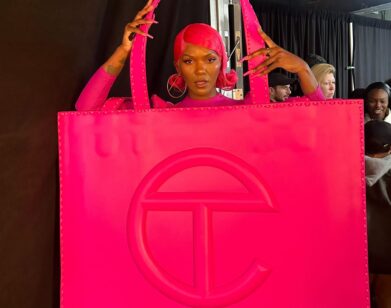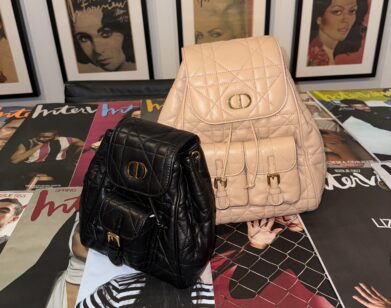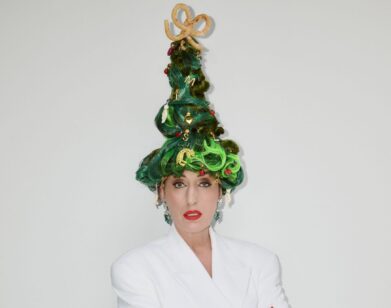Rodarte
What is it about Rodarte, the sister team who, in seven short seasons, have consistently managed to make shockingly original but beautifully feminine clothes that look like nothing else in the land of fashion? Maybe it’s that Kate and Laura Mulleavy, who grew up in Northern California and live in Los Angeles, are design libertarians, working far outside of the style capitals, so they can let their own imaginations breathe. The lush ice-cream pastels of Spring 2008 took a dangerous turn through some serious Japanese horror-movie chic for fall (complete with blood red stained and slashed dresses) without ever losing the poetry that has become the touchstone of their work. Here, the Mulleavys talk with actress Natalie Portman, whom they met earlier this year before making her a dress for the premiere of her film The Other Boleyn Girl. That movie was about two sisters, and so is this interview with Kate, 29, and Laura, 28. Thankfully, this story has a happier ending.
NATALIE PORTMAN: You lived with your parents after college.
KATE MULLEAVY: It was cool, in a way. We grew up in Northern California, in a small town right next to Santa Cruz. It’s called Aptos. Have you seen that movie The Lost Boys? That’s what our town was like. Laura and I are still obsessed with vampires. Then we both went to college at Berkeley.
NP: What did you study?
KM: I was an art-history major. Laura started as-
LAURA MULLEAVY: A biology major.
KM: She was going to be a doctor.
LM: Then I switched after my first semester to English.
KM: Anyway, we moved back home after we finished school.
LM: I didn’t want to be an English professor, and Kate didn’t want to work in museums. We wanted to design. So we thought the best way to approach becoming designers was to move home and watch horror films for a year! Our parents thought we were losers. We didn’t tell our friends.
KM: When I was 6, I would tell people, “I want to be a fashion designer.” And so, when we left school, I said, “We have a lot of research to do. I’m really interested in horror films right now, so we should start watching as many as we can.” Our parents never once said to us in that year after school, “You guys . . . ” Most kids come out of college and they—
LM: Want to live on their own.
KM: We were like, “Oh, got to get to the video store.”
LM: We had planned this trip to Italy. But both of us have really obsessive personalities, and we overplanned it so much that we canceled it.
KM: We really didn’t know what we were doing. I remember thinking, We have a little of this money from the trip, and if we sell all of my records . . . I had a huge collection.
NP: Did you get any of them back?
KM: No.
LM: That’s the horrible part. We sold them to Amoeba [Records] in L.A.
KM: We had all these crazy albums-really special ones that my dad had collected.
NP: Like what?
We thought the best way to approach becoming designers was to move home and watch horror films for a year! Our parents thought we were losers. We didn’t tell our friends.Laura Mulleavy
KM: There were things like blues albums recorded when an artist would go into a radio station. Those were valuable. There was the Velvet Underground,a first pressing, and Black Sabbath’s first album. I just remember my dad gave that to me and said, “I want you to know this is rare. You don’t come across this album in this good condition-this is a party record. There are no scratches.” I was like, “Dad, there are a million copies out there.” But you attach memories to things. At the same time, it was kind of liberating. You realize that material objects really don’t define who you are and that you can let go of things.
NP: Did you make all of the clothes yourselves?
LM: We started with 10 pieces and then we figured out how to grow a little more and to invite people with whom we could have an artistic connection. I think that has been the hardest part and the best part of promoting what we’re doing.
NP: So you took those 10 pieces to New York?
KM and LM: We’d never been to New York!
KM: You would have thought we were in the ’30s, going to the big city.
LM: We got off the train and someone tried to steal my luggage.
KM: We didn’t know anyone in fashion, really. I’d hand-done paper dolls with little clothes, and we sent them out. And Women’s Wear Daily called us.
LM: It was three days before Fashion Week. They called us in and they just put us on the cover. It happened really quickly.
NP: That’s crazy.
KM: Then we came back to L.A., and a few weeks later [Vogue editor-in-chief] Anna Wintour came and saw us. We had only done 10 pieces.
NP: And you hadn’t shown.
KM: No. We didn’t even know we had to sell them.
LM: You pick it up as you go along. For our first presentation, we just invited all of our school friends out to be our fake casting people and our fake producers. It was a bunch of misfits. We didn’t even know how to get models. All we had to offer was free chocolate, and copies of Fanny and Alexander. We asked Criterion Collection to go in with us. Now we always do a movie tied to each show.
NP: What are some other movies that you’ve worked into your collections?
KM: Last season was all about Japanese horror. We were really interested in Japanese horror as a genre. You always see the same visuals. It’s like the girl with the hair in her face-
LM: The spirit girl with the darkened eyes—
KM: They’re all painted white. They’re an extension of Kabuki theater. You have suspense and horror that are more related to this idea of a spirit culture, versus the Western tradition where a film tends to be related to a religious paradigm.
LM: Good and evil. The devil.
KM: Like The Omen, Rosemary’s Baby. But then we were interested in A Tale of Two Sisters.
NP: A Tale of Two Sisters? Is that your life story?
LM: In the posters, these girls are in little white schoolgirl dresses and they’re all covered in blood. So we wanted to do these blood-soaked dresses.
KM: We didn’t even know when we were doing it.
LM: I was like, “Kate, I want to make these bloody dresses and the red has to be perfect, so we can’t do it as a print.” We spent three months developing the red and not letting it bleed into the white. That was the hard part-every night, meeting with our dyer, who is just a mad genius.
KM: But the season before, we did Japanese animated film. So the two collections were kind of-
LM: An extension of each other.
NP: What’s it like being in L.A. with all the fashion in New York or Paris?
LM: It’s been really amazing. It was easy for us to find a world that we could create for ourselves, and then our friends all do different, interesting things that are not involved in our work.
KM: L.A. is kind of a strange, beautiful creature. When we moved from Northern California it was overwhelming. But when you get to know L.A., you find hidden treasures.
LM: In a city like New York, you can go into any world and experience it. In L.A., you have to know it, you have to be invited. Subcultures here are really incredible, and there’s a certain freedom.
Rodarte
What is it about Rodarte, the sister team who, in seven short seasons, have consistently managed to make shockingly original but beautifully feminine clothes that look like nothing else in the land of fashion? Maybe it’s that Kate and Laura Mulleavy, who grew up in Northern California and live in Los Angeles, are design libertarians, working far outside of the style capitals, so they can let their own imaginations breathe. The lush ice-cream pastels of Spring 2008 took a dangerous turn through some serious Japanese horror-movie chic for fall (complete with blood red stained and slashed dresses) without ever losing the poetry that has become the touchstone of their work. Here, the Mulleavys talk with actress Natalie Portman, whom they met earlier this year before making her a dress for the premiere of her film The Other Boleyn Girl. That movie was about two sisters, and so is this interview with Kate, 29, and Laura, 28. Thankfully, this story has a happier ending.
NATALIE PORTMAN: You lived with your parents after college.
KATE MULLEAVY: It was cool, in a way. We grew up in Northern California, in a small town right next to Santa Cruz. It’s called Aptos. Have you seen that movie The Lost Boys? That’s what our town was like. Laura and I are still obsessed with vampires. Then we both went to college at Berkeley.
NP: What did you study?
KM: I was an art-history major. Laura started as-
LAURA MULLEAVY: A biology major.
KM: She was going to be a doctor.
LM: Then I switched after my first semester to English.
KM: Anyway, we moved back home after we finished school.
LM: I didn’t want to be an English professor, and Kate didn’t want to work in museums. We wanted to design. So we thought the best way to approach becoming designers was to move home and watch horror films for a year! Our parents thought we were losers. We didn’t tell our friends.
KM: When I was 6, I would tell people, “I want to be a fashion designer.” And so, when we left school, I said, “We have a lot of research to do. I’m really interested in horror films right now, so we should start watching as many as we can.” Our parents never once said to us in that year after school, “You guys . . . ” Most kids come out of college and they—
LM: Want to live on their own.
KM: We were like, “Oh, got to get to the video store.”
LM: We had planned this trip to Italy. But both of us have really obsessive personalities, and we overplanned it so much that we canceled it.
KM: We really didn’t know what we were doing. I remember thinking, We have a little of this money from the trip, and if we sell all of my records . . . I had a huge collection.
NP: Did you get any of them back?
KM: No.
LM: That’s the horrible part. We sold them to Amoeba [Records] in L.A.
KM: We had all these crazy albums-really special ones that my dad had collected.
NP: Like what?
We thought the best way to approach becoming designers was to move home and watch horror films for a year! Our parents thought we were losers. We didn’t tell our friends.Laura Mulleavy
KM: There were things like blues albums recorded when an artist would go into a radio station. Those were valuable. There was the Velvet Underground,a first pressing, and Black Sabbath’s first album. I just remember my dad gave that to me and said, “I want you to know this is rare. You don’t come across this album in this good condition-this is a party record. There are no scratches.” I was like, “Dad, there are a million copies out there.” But you attach memories to things. At the same time, it was kind of liberating. You realize that material objects really don’t define who you are and that you can let go of things.
NP: Did you make all of the clothes yourselves?
LM: We started with 10 pieces and then we figured out how to grow a little more and to invite people with whom we could have an artistic connection. I think that has been the hardest part and the best part of promoting what we’re doing.
NP: So you took those 10 pieces to New York?
KM and LM: We’d never been to New York!
KM: You would have thought we were in the ’30s, going to the big city.
LM: We got off the train and someone tried to steal my luggage.
KM: We didn’t know anyone in fashion, really. I’d hand-done paper dolls with little clothes, and we sent them out. And Women’s Wear Daily called us.
LM: It was three days before Fashion Week. They called us in and they just put us on the cover. It happened really quickly.
NP: That’s crazy.
KM: Then we came back to L.A., and a few weeks later [Vogue editor-in-chief] Anna Wintour came and saw us. We had only done 10 pieces.
NP: And you hadn’t shown.
KM: No. We didn’t even know we had to sell them.
LM: You pick it up as you go along. For our first presentation, we just invited all of our school friends out to be our fake casting people and our fake producers. It was a bunch of misfits. We didn’t even know how to get models. All we had to offer was free chocolate, and copies of Fanny and Alexander. We asked Criterion Collection to go in with us. Now we always do a movie tied to each show.
NP: What are some other movies that you’ve worked into your collections?
KM: Last season was all about Japanese horror. We were really interested in Japanese horror as a genre. You always see the same visuals. It’s like the girl with the hair in her face-
LM: The spirit girl with the darkened eyes—
KM: They’re all painted white. They’re an extension of Kabuki theater. You have suspense and horror that are more related to this idea of a spirit culture, versus the Western tradition where a film tends to be related to a religious paradigm.
LM: Good and evil. The devil.
KM: Like The Omen, Rosemary’s Baby. But then we were interested in A Tale of Two Sisters.
NP: A Tale of Two Sisters? Is that your life story?
LM: In the posters, these girls are in little white schoolgirl dresses and they’re all covered in blood. So we wanted to do these blood-soaked dresses.
KM: We didn’t even know when we were doing it.
LM: I was like, “Kate, I want to make these bloody dresses and the red has to be perfect, so we can’t do it as a print.” We spent three months developing the red and not letting it bleed into the white. That was the hard part-every night, meeting with our dyer, who is just a mad genius.
KM: But the season before, we did Japanese animated film. So the two collections were kind of-
LM: An extension of each other.
NP: What’s it like being in L.A. with all the fashion in New York or Paris?
LM: It’s been really amazing. It was easy for us to find a world that we could create for ourselves, and then our friends all do different, interesting things that are not involved in our work.
KM: L.A. is kind of a strange, beautiful creature. When we moved from Northern California it was overwhelming. But when you get to know L.A., you find hidden treasures.
LM: In a city like New York, you can go into any world and experience it. In L.A., you have to know it, you have to be invited. Subcultures here are really incredible, and there’s a certain freedom.

